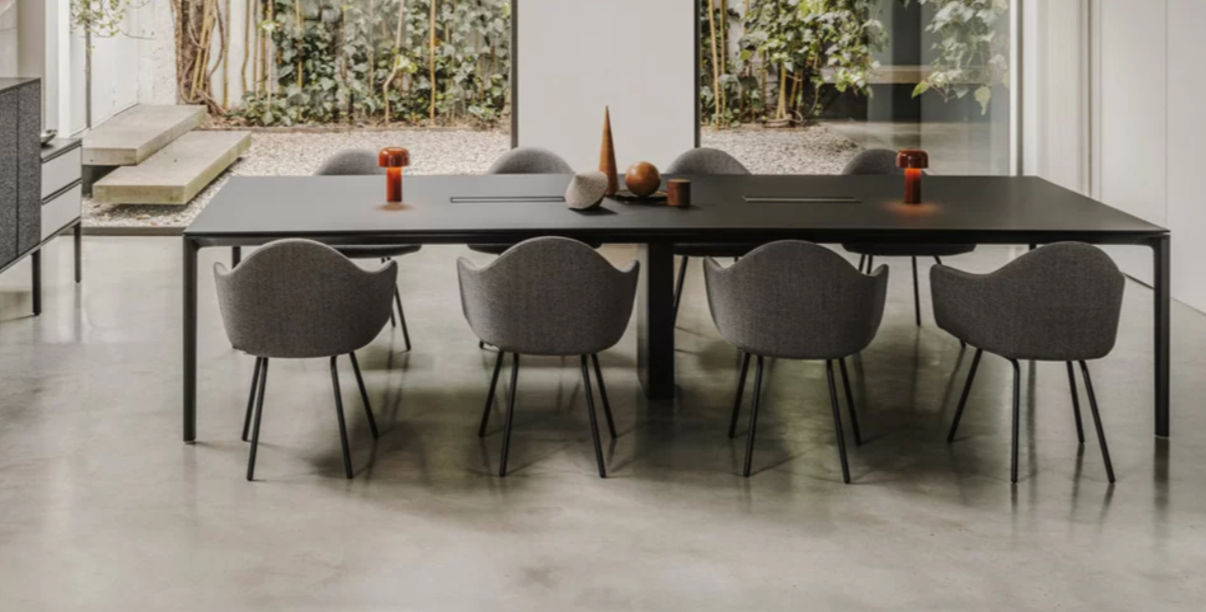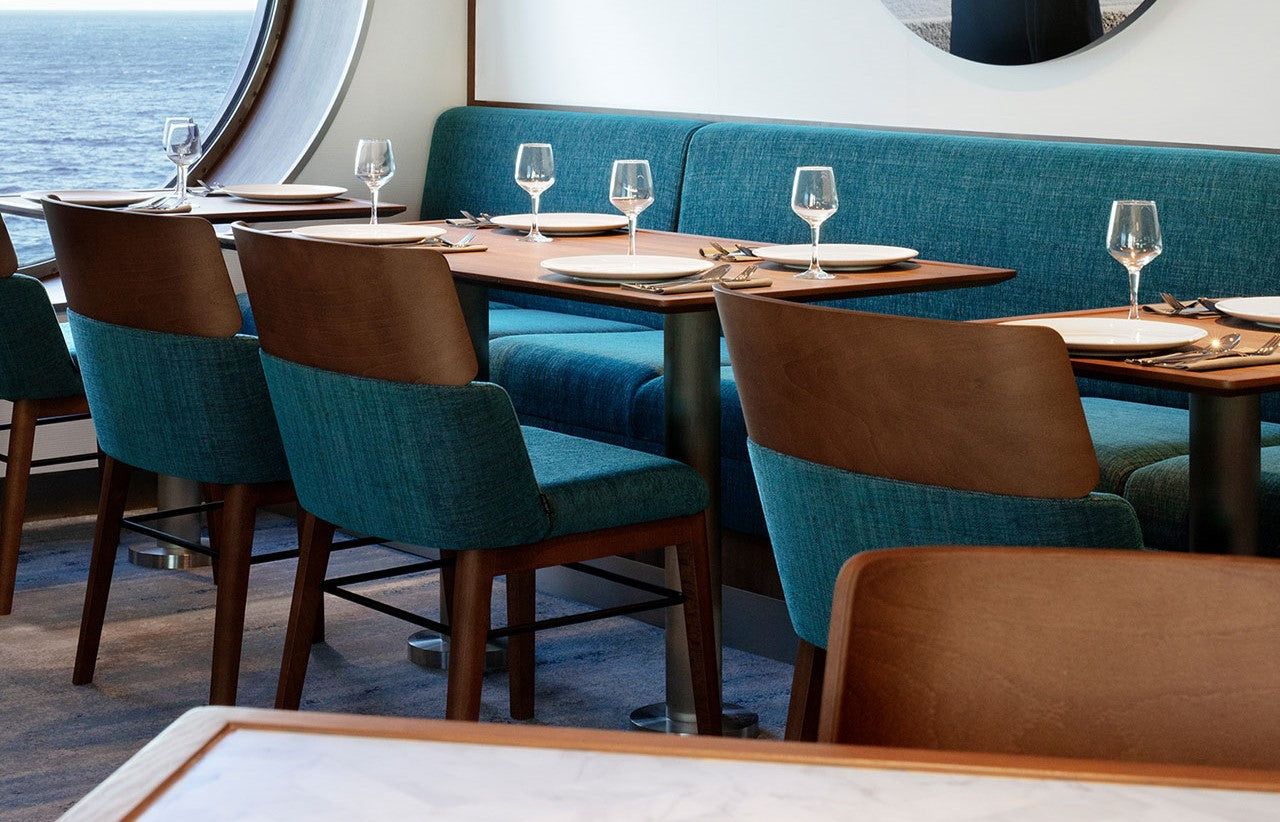
The Secret to Choosing Luxury Dining Tables That Work in Open-Concept Homes
Open-concept living has become the gold standard in modern interior design. It celebrates flow, light, and spaciousness, creating a sense of openness that connects dining, living, and kitchen areas. But with that openness comes a challenge: how do you define spaces without using walls?
A luxury dining table isn’t just a setting for meals, it’s a structural cue. It signals purpose, invites gathering, and creates balance in an otherwise unbroken layout. As Architectural Digest puts it,
“A well-designed dining space can inspire lively conversation, foster dinner parties that last hours, and serve as a backdrop for important decisions made over good food.”
That’s a big role to play, and the right table makes it look effortless.
We’ve curated four distinct styles that not only enhance the visual flow of large spaces but also reflect today’s top priorities: sustainable materials, architectural form, and multifunctional design. These include:
-
Natural-material dining tables that ground and warm the room
-
Extendable tables that flex with your lifestyle
-
Pedestal-base styles that promote smooth movement
-
Glass-top contemporary dining tables that reflect light and open up space
Each modern table featured below has been chosen with open layouts in mind - tables that help you delineate space through style, not walls.
Natural-Material Luxury Dining Tables: Grounding Warmth in Expansive Spaces
In large, airy spaces, natural materials are essential for adding warmth and grounding the design. Texture and tone offer a powerful way to create comfort, particularly in open areas that can otherwise feel austere or unfinished. Tables made from wood, stone, or ceramic introduce these elements beautifully.
Why Natural-Material Tables Help Define and Warm Open Spaces
-
Add organic texture and tactile richness, softening the sharp lines common in modern architecture.
-
Create visual continuity when paired with natural flooring, garden views, or timber accents.
-
Anchor open-concept spaces by introducing grounded, handcrafted design elements.
-
Contrast beautifully with industrial finishes like concrete or steel for a layered, curated aesthetic.
-
Help reduce echo in large rooms, especially effective in lofts or homes with high ceilings and hard surfaces.
Top Picks for Natural-Material Contemporary Dining Tables
-
Pechino Table by Studio Kappa for Midj
With a base of intertwined painted steel beams and a choice of solid wood, veneer, or glass top, the Pechino is a bold yet organic rectangular dining table. It’s also one of our top recommendations for open space areas due to its architectural presence. -
Monoplauto Table by Paolo Capello & Simone Sabatti for Miniforms
A refined evolution of the Plauto design, this oval pedestal dining table features a central monolithic base, available in wood, ceramic, or marble, emphasizing stability and sculptural elegance. -
Fork Table by Tomoya Tabuchi for Lapalma
Rooted in Japanese philosophy and Italian craft, Fork’s wood and powder-coated base evokes the branches of a tree. It's part of a modular system available in a range of shapes and finishes.

We’ve noticed that clients with high ceilings or concrete floors gravitate toward natural wood finishes to soften the acoustics and add visual warmth.
Extendable Dining Tables: Elegant Flexibility for Every Occasion
Open spaces demand flexibility and the extendable dining room table is the unsung hero of modern design. This style reflects the growing need for furniture that adapts, not just decorates. They’re ideal for multifunctional layouts, especially when the dining space flows into the kitchen or living room.
Why Extendable Dining Tables Offer Flexibility in Open-Plan Living
-
Adapt to different needs - expand for hosting, retract for everyday use.
-
Let you reconfigure space quickly without compromising on elegance or proportions.
-
Provide functionality in shared zones that might serve as dining, workspace, or family room.
-
Allow you to scale seating up or down without changing the overall look of the space.
-
Great investment for clients who entertain occasionally but value a clean, uncluttered floor plan.
Our 3 Top Extendable Rectangular Dining Table Designs to Consider:
-
Diamante Table by Studio Kappa for Midj
This stunning piece offers lacquered steel legs and a top in glass, ceramic, or laminate. Its geometric silhouette and intuitive extendable function reflect Midj’s signature craftsmanship. -
Artu Table by Andrea Lucatello for Miniforms
With medieval inspiration and contemporary execution, Artu's architectural base anchors the dining area. The extendable version is ideal for open layouts needing structure and scale. -
Alfred Table by Midj R&D for Midj
Designed to adapt to the rhythm of daily life, Alfred features a semi-automatic extension system with a glass or ceramic top and lacquered steel base. Its clean lines blend beautifully with minimalist interiors.

3 Ways to Style Extendable Tables:
-
Use symmetrical pendant lighting to balance both extended and retracted setups.
-
Choose armless chairs for easy repositioning.
-
Keep the centerpiece light and movable, like a low tray or vase.
As Decorilla’s 2025 dining trends show, modular and adaptable furniture is essential for modern homes. These tables meet the moment.
Pedestal Base Tables: Enhancing Flow Without Bulk
In open-concept layouts, a pedestal base does more than hold up a tabletop - it anchors a room with visual elegance and unexpected fluidity. With no obstructive legs at the corners, these tables promote seamless movement and better use of surrounding space. They help define zones, especially in rooms that blend kitchen, dining, and living areas.
How Pedestal Tables Maximize Space and Improve Flow:
-
Free up legroom and make it easier to circulate around the table - especially important in tighter layouts.
-
Create uninterrupted seating around the entire perimeter, perfect for maximizing guest capacity.
-
Keep the design light and clean by removing the visual weight of four-legged frames.
-
Function as central design pieces without adding bulk—ideal for zoning without walls.
-
Complement curved or circular layouts often found in luxury loft and coastal homes.
Our Top Recommendations for Pedestal Tables:
-
Illo Table by Miniforms Lab for Miniforms
With exaggerated curves and soft lines, Illo feels like functional art. The lacquered wood top comes in wood, marble, ceramic, or lacquer finishes, with the option to accent the lacquered metal base in copper. Its playful design makes it ideal for injecting personality into minimalist layouts. -
Bol Table by Zaven for Zanotta
Designed with a sculptural edge, the Bol Table is available in both round and oval configurations, making it ideal for dynamic open-concept spaces. Its signature asymmetry is defined by one leg derived from the tabletop’s perimeter, creating a visual twist that shifts with every angle.
Whether you choose the 53.1" or 63" round diameter or opt for a more expansive oval version, the MDF top and matte lacquered polyurethane base create a bold architectural presence. As a luxury round dining table, Bol brings both function and fluidity to lofts and contemporary interiors.
-
Clessidra Table by Paolo Vernier for Midj
Aptly named after the hourglass, Clessidra is both symmetrical and bold. Available in metal or wood bases, with ceramic, metal, or marble tops, it was recognized in the 2021 German Design Award and the Edward Haimsohn Design Award. This round dining table has a two-tone base option that adds a striking contrast to open interiors with monochrome palettes.

These bases support the emerging trend toward bold sculptural furniture that zones spaces through form rather than barriers.
Glass-Top Contemporary Dining Tables That Open Up Modern Spaces
Glass dining tables work beautifully in open-concept homes. They preserve sightlines, reflect light, and amplify surrounding textures. Far from being cold or clinical, today’s glass designs incorporate grounding materials like wood or stone in the base to add balance and depth.
Why Glass-Top Tables Enhance Light and Openness in Large Rooms
-
Maintain a spacious feel by allowing light and sightlines to pass through uninterrupted.
-
Highlight architectural bases that might otherwise be hidden, letting form be part of the function.
-
Mix effortlessly with other luxury materials like stone, wood, and brushed metal.
-
Increase perceived space in smaller open-concept zones or darker interiors.
-
Offer a polished, modern look while still allowing the table to feel visually light and airy.
Standout Glass Table Designs:
-
Acco Table by Florian Schmid for Miniforms
A symphony of craftsmanship, the Acco is available in round and elliptical versions, making it a standout luxury round dining table for open-concept layouts. Its base is composed of fine wooden slats, arranged in a rhythmic, sculptural formation that creates gentle movement beneath a glass, ceramic, or wood top. The design balances minimalism with artisan detail, ideal for clients who favor quiet sophistication in a fluid, modern space. -
Nexus Table by Andrea Lucatello for Midj
Designed by Andrea Lucatello, the Nexus brings futurism into the dining space. Its base is crafted from Baydur, a strong, scratch-resistant polymer that mimics concrete. With a clear glass or designer ceramic top, it feels architectural and raw, especially when styled with leather or metal chairs. -
Pechino Table (Glass Top Option) by Studio Kappa for Midj
With intertwined metal beams forming a geometric foundation, Pechino’s rectangular dining table offers visual complexity that’s beautifully revealed beneath a clear glossy, or scratch-resistant glass top. This piece is especially powerful in homes with concrete floors or black-framed windows, echoing the architectural strength of the space.
We’ve tested glass-topped contemporary dining tables in both urban lofts and coastal homes, and they consistently make the space feel more expansive. They’re also a favorite among clients who prioritize clean lines and modern finishes.
Q&A: Choosing the Right Table for Your Space
Q: Is rectangular or round better in open layouts?
A: Rectangular works well for aligning with walls or zoning long spaces. A luxury round dining table set softens central layouts and encourages circulation.
Q: Should my table match my kitchen finishes?
A: Not necessarilycontrast creates interest. Try matching warm woods with cool metals, or pairing glass tops with natural flooring.
Q: How do I anchor my dining zone without walls?
A: Use custom size area rugs, pendant lighting, and sculptural bases. Pedestal or natural material tables are especially effective.



